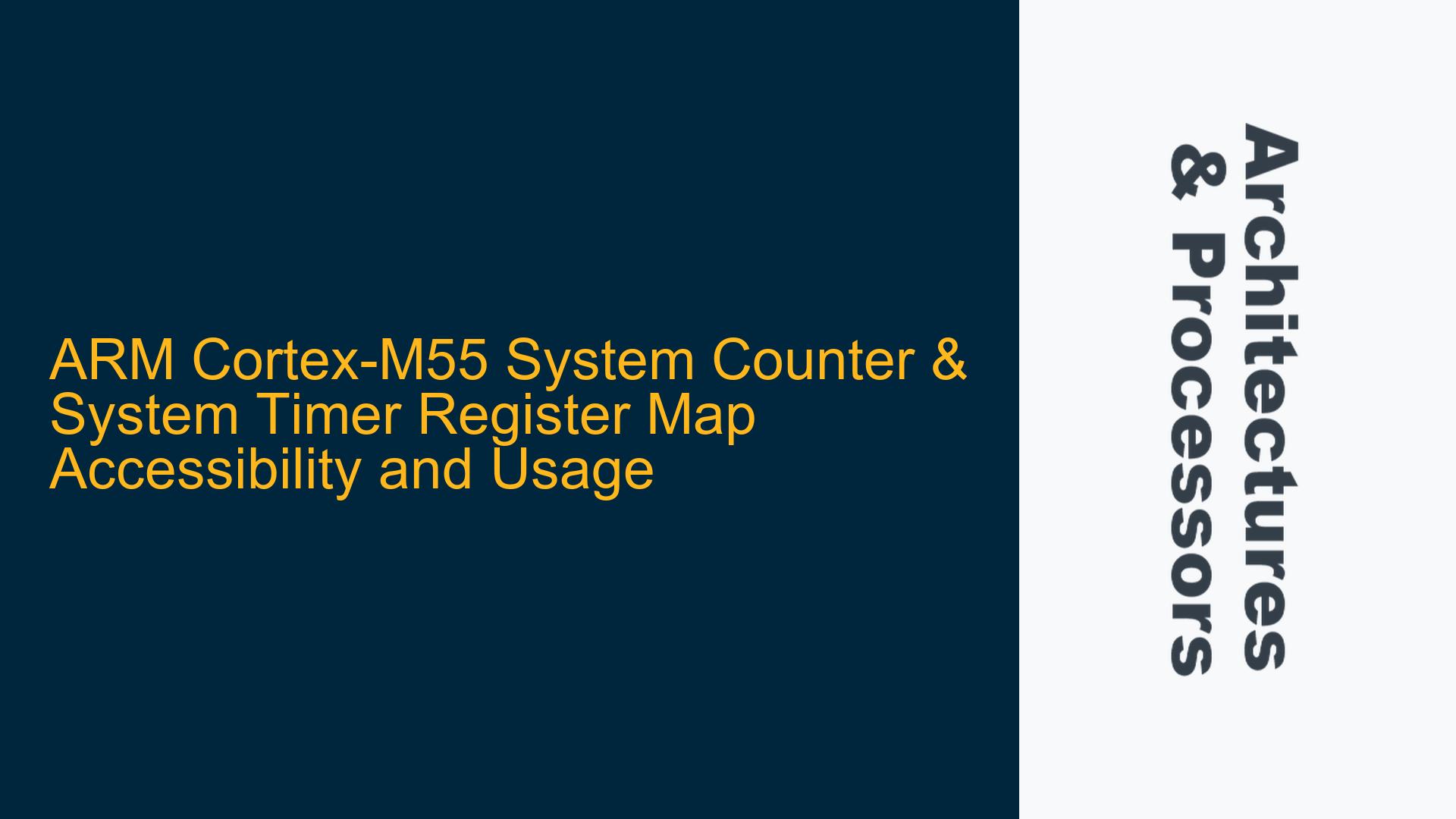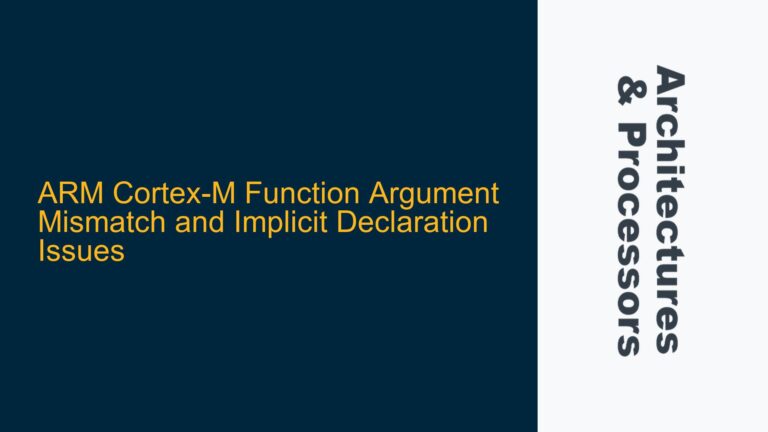ARM Cortex-M55 System Counter and System Timer Register Map Accessibility
The ARM Cortex-M55 processor incorporates a sophisticated System Counter and System Timer, which are critical for real-time operations and system synchronization. The System Counter provides a continuous timebase, while the System Timer generates periodic interrupts based on this timebase. These components are essential for tasks such as task scheduling, time-stamping, and synchronization in embedded systems.
The register maps for these components are documented in the ARM architecture reference manuals. However, the documentation is often spread across multiple sections, making it challenging to obtain a consolidated view. The primary documentation for the System Counter and System Timer can be found at the following links:
These documents provide detailed descriptions of each register, including their offsets, access types, and functionalities. However, the need for a more accessible and concise representation, such as an HTML or XML format, has been expressed by developers working with the Cortex-M55.
Challenges in Obtaining Clean & Concise Register Map Representations
The primary challenge lies in the format and accessibility of the register maps. While the ARM documentation is comprehensive, it is often presented in a manner that requires significant navigation and cross-referencing. This can be particularly cumbersome when developers need to quickly reference register details during firmware development or debugging.
The System Counter and System Timer registers are part of the "External Registers" section in the ARM documentation. These registers are crucial for configuring and controlling the timing mechanisms in the Cortex-M55. However, the documentation does not provide a single, consolidated HTML or XML file that developers can easily parse or integrate into their development environments.
The absence of a clean and concise register map representation can lead to several issues:
- Increased Development Time: Developers spend more time navigating through documentation rather than focusing on actual development tasks.
- Potential for Errors: Manual extraction and interpretation of register details can lead to mistakes, especially when dealing with complex register fields and bitmasks.
- Inefficient Debugging: Without a consolidated register map, debugging timing-related issues becomes more challenging, as developers need to constantly refer back to the documentation.
Implementing Accessible Register Maps for System Counter and System Timer
To address the challenges associated with the accessibility of the System Counter and System Timer register maps, developers can utilize the resources provided by ARM. The ARM Exploration Tools page offers downloadable XML and HTML representations of the register maps, which can significantly streamline the development process.
Accessing Register and ISA XML
The ARM Exploration Tools page provides a comprehensive collection of XML and HTML files that describe the ARM architecture, including the System Counter and System Timer registers. These files can be accessed at the following link:
The XML files available on this page include detailed descriptions of the ARM instruction set architecture (ISA) and the external registers, including those for the System Counter and System Timer. The HTML rendering of these XML files provides a more user-friendly interface for navigating the register maps.
Utilizing the HTML Rendering
The HTML rendering of the register maps is particularly useful for developers who prefer a graphical interface. The HTML pages are organized by register offset, making it easy to locate specific registers and their associated fields. The System Counter and System Timer registers are categorized under the "External Registers" section, which can be accessed directly via the following link:
This page provides a tabular view of the registers, including their offsets, names, and brief descriptions. Each register entry is linked to a more detailed description, which includes information on the register’s fields, access types, and reset values.
Downloading and Integrating XML Files
For developers who prefer to work with XML files, the ARM Exploration Tools page also offers downloadable archives containing the XML representations of the register maps. These XML files can be integrated into custom tools or scripts to automate the generation of register definitions and access functions.
The XML files are structured in a way that allows for easy parsing and extraction of register details. Each register is represented as an XML element, with child elements describing the register’s fields, bitmasks, and access types. This structured format enables developers to programmatically generate header files, access macros, and other resources that simplify the interaction with the System Counter and System Timer registers.
Example: Parsing XML for System Timer Registers
Consider the following example of how the XML representation of the System Timer registers can be parsed to generate C header files:
<register>
<name>CNTBase</name>
<offset>0x0000</offset>
<size>32</size>
<access>read-write</access>
<reset_value>0x00000000</reset_value>
<fields>
<field>
<name>ENABLE</name>
<bit_offset>0</bit_offset>
<bit_width>1</bit_width>
<access>read-write</access>
<description>Enables the System Timer.</description>
</field>
<field>
<name>INT_STATUS</name>
<bit_offset>1</bit_offset>
<bit_width>1</bit_width>
<access>read-only</access>
<description>Indicates the interrupt status of the System Timer.</description>
</field>
</fields>
</register>
This XML snippet describes the CNTBase register, which is part of the System Timer. The register has two fields: ENABLE and INT_STATUS. The ENABLE field is a single-bit field that controls the enabling of the System Timer, while the INT_STATUS field indicates the interrupt status.
Using an XML parser, developers can extract this information and generate corresponding C definitions:
#define CNTBASE_OFFSET 0x0000
#define CNTBASE_ENABLE_MASK 0x00000001
#define CNTBASE_INT_STATUS_MASK 0x00000002
#define CNTBASE_ENABLE_POS 0
#define CNTBASE_INT_STATUS_POS 1
#define CNTBASE_ENABLE(x) ((x) << CNTBASE_ENABLE_POS)
#define CNTBASE_INT_STATUS(x) ((x) << CNTBASE_INT_STATUS_POS)
These definitions can then be used in the firmware to interact with the System Timer registers:
void enable_system_timer(void) {
uint32_t cntbase = read_reg(CNTBASE_OFFSET);
cntbase |= CNTBASE_ENABLE(1);
write_reg(CNTBASE_OFFSET, cntbase);
}
uint32_t get_system_timer_interrupt_status(void) {
uint32_t cntbase = read_reg(CNTBASE_OFFSET);
return (cntbase & CNTBASE_INT_STATUS_MASK) >> CNTBASE_INT_STATUS_POS;
}
Best Practices for Using Register Maps
When working with the System Counter and System Timer registers, it is important to follow best practices to ensure reliable and efficient system operation:
-
Consistent Register Access: Always use the provided register definitions and access macros to interact with the registers. This ensures that the correct bitmasks and offsets are used, reducing the risk of errors.
-
Atomic Operations: When modifying register fields that control critical system functions, such as enabling the System Timer, use atomic operations to prevent race conditions. This is particularly important in multi-threaded or interrupt-driven environments.
-
Error Handling: Implement error handling mechanisms to detect and recover from incorrect register configurations. For example, if the System Timer fails to enable, the firmware should log the error and take appropriate action, such as resetting the timer or entering a safe state.
-
Documentation: Maintain up-to-date documentation of the register configurations and access patterns. This is especially important when working with complex systems where multiple developers may be interacting with the same registers.
-
Testing and Validation: Thoroughly test and validate the register configurations to ensure that the System Counter and System Timer operate as expected. This includes testing edge cases, such as maximum and minimum timer values, and verifying that interrupts are generated correctly.
Conclusion
The ARM Cortex-M55 System Counter and System Timer are essential components for real-time operations in embedded systems. While the ARM documentation provides detailed descriptions of the associated registers, the lack of a consolidated and accessible register map can hinder development efficiency. By utilizing the XML and HTML resources available on the ARM Exploration Tools page, developers can streamline the process of accessing and interacting with these registers. Implementing best practices for register access and configuration further ensures reliable and efficient system operation.





